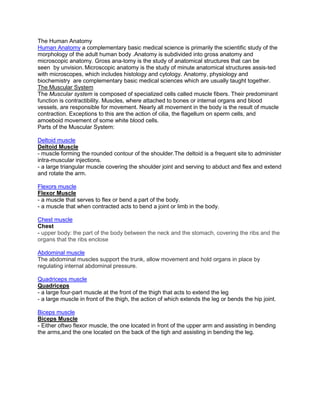
The Human Anatomy.docx
- 1. The Human Anatomy Human Anatomy a complementary basic medical science is primarily the scientific study of the morphology of the adult human body .Anatomy is subdivided into gross anatomy and microscopic anatomy. Gross ana-tomy is the study of anatomical structures that can be seen by unvision. Microscopic anatomy is the study of minute anatomical structures assis-ted with microscopes, which includes histology and cytology. Anatomy, physiology and biochemistry are complementary basic medical sciences which are usually taught together. The Muscular System The Muscular system is composed of specialized cells called muscle fibers. Their predominant function is contractibility. Muscles, where attached to bones or internal organs and blood vessels, are responsible for movement. Nearly all movement in the body is the result of muscle contraction. Exceptions to this are the action of cilia, the flagellum on sperm cells, and amoeboid movement of some white blood cells. Parts of the Muscular System: Deltoid muscle Deltoid Muscle - muscle forming the rounded contour of the shoulder.The deltoid is a frequent site to administer intra-muscular injections. - a large triangular muscle covering the shoulder joint and serving to abduct and flex and extend and rotate the arm. Flexors muscle Flexor Muscle - a muscle that serves to flex or bend a part of the body. - a muscle that when contracted acts to bend a joint or limb in the body. Chest muscle Chest - upper body: the part of the body between the neck and the stomach, covering the ribs and the organs that the ribs enclose Abdominal muscle The abdominal muscles support the trunk, allow movement and hold organs in place by regulating internal abdominal pressure. Quadriceps muscle Quadriceps - a large four-part muscle at the front of the thigh that acts to extend the leg - a large muscle in front of the thigh, the action of which extends the leg or bends the hip joint. Biceps muscle Biceps Muscle - Either oftwo flexor muscle, the one located in front of the upper arm and assisting in bending the arms,and the one located on the back of the tigh and assisting in bending the leg.
- 2. The Skeletal System The Skeletal system serves many important functions; it provides the shape and form for our bodies in addition to supporting, protecting, allowing bodily movement, producing blood for the body, and storing minerals. FUNCTIONS: Its 206 bones form a rigid framework to which the softer tissues and organs of the body are attached. Vital organs are protected by the skeletal system. The brain is protected by the surrounding skull as the heart and lungs are encased by the sternum and rib cage. Bones serve as a storage area for minerals such as calcium and phosphorus. When an excess is present in the blood, buildup will occur within the bones. When the supply of these minerals within the blood is low, it will be withdrawn from the bones to replenish the supply. Parts of the Skeletal System: Skull Rib cage Humerus Radius Ulna Fibula Tibia Femur Patella Pelvis Spine Clavicle The Circulatory System The circulatory system is made up of your heart and blood vessels. Blood vessels are flexible, hollow tubes. The heart pumps blood through blood vessels. It sends blood to your lungs to pick up oxygen. It pumps blood out to all parts of your body. Arteries are blood vessels that carry oxygen-rich blood out to your body. Veins are blood vessels that carry blood back to your heart. The blood vessels near your heart are thick. Farther from your heart, the blood vessels are smaller. The tiniest blood vessels are called Capillaries. Capillaries go all through your body. They give up oxygen and nutrients that your body needs. They carry away waste products. Capillaries-an extremely narrow thin-walled blood vessel that connects small arteries arterioles with small veins venules to form a network throughout the body
- 3. Arteries - carry blood from heart to the lungs. They are the only arteries (other than umbilical arteries in the fetus) that carry deoxygenated blood. Veins - carry oxygen-rich blood from the lungs to the left atrium of the heart. They are the only veins in the post-fetal human body that carry oxygenated (red) blood. Heart - the heart pumps oxygenated blood to the body and deoxygenated blood to the lungs. In the human heart there is one atrium and one ventricle for each circulation, and with both a systemic and a pulmonary circulation there are four chambers in total: left atrium, left ventricle, right atrium and right ventricle.